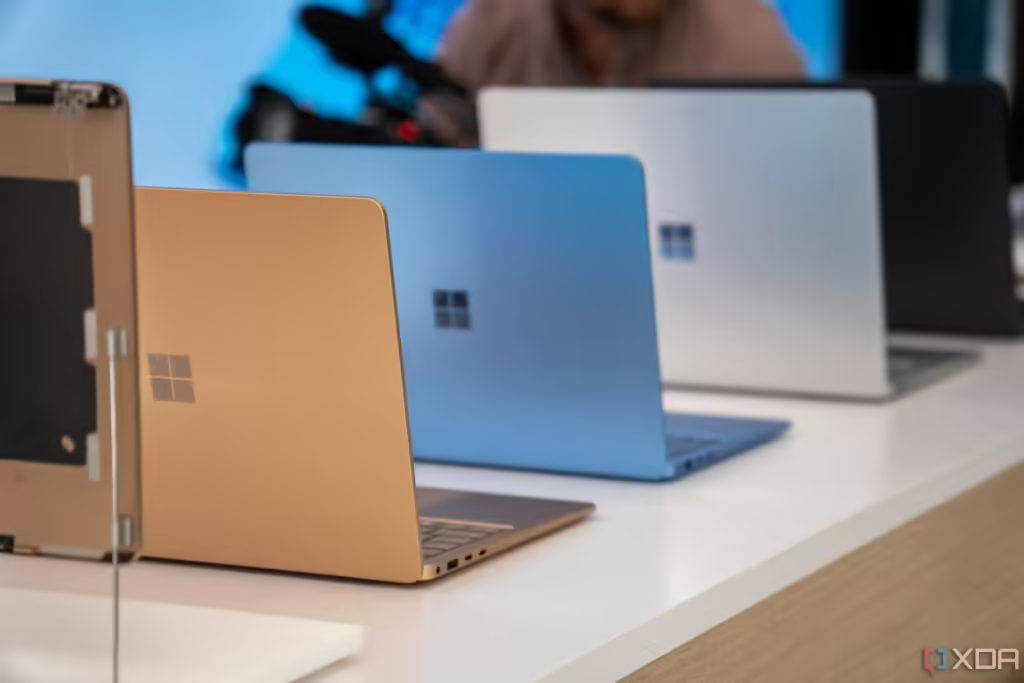When the Microsoft Surface Laptop 7th Edition—which comes equipped with the Qualcomm Snapdragon X Elite X1E80100 processor—is released, the long-running dispute between Apple and Microsoft reaches a new height. Much like Apple did when it switched to its own silicon, Microsoft has made a big change with this chipset. With Apple’s MacBook Pro 14 M3 from 2023, how does this new competitor compare? So let’s take a closer look at their attributes, functionality, style, and allure.
The Surface Laptop 7th Edition is celebrated for its sleek, minimalist design, making a bold statement with its svelte aluminum chassis. It exudes a premium feel, available in sophisticated colors like Sapphire and Dune, alongside traditional black and silver options. Despite its elegant appearance, some critiques have surfaced regarding its practicality in everyday use.
On the positive side, the Surface Laptop impresses with its bright and responsive touch display, delivering a fluid user experience with a 120Hz refresh rate. This feature is particularly appealing for users who prioritize visual clarity and smooth interactions. The laptop’s performance is bolstered by the Snapdragon X Elite X1E80100 processor and Qualcomm Adreno GPU, ensuring snappy responsiveness across various tasks.
Battery life is another standout feature, lasting an impressive 15 hours and 44 minutes on the Laptop Mag battery test, making it a reliable companion for extended work sessions or travel. However, it falls short in certain areas critical to user experience. The display, while bright and responsive, has been criticized for its color accuracy and noticeable ghosting during fast-paced movements on screen. This issue can detract from the overall viewing experience, especially for users engaged in multimedia or gaming activities.
The keyboard and graphics performance also leave room for improvement. The Surface Laptop’s keyboard is noted for its shallow key travel, which may not suit users accustomed to more tactile feedback from their typing experience. Graphics performance, powered by the integrated Qualcomm Adreno GPU, is serviceable but lacks the robustness expected for demanding graphical applications or gaming.
On the other side of the ring stands Apple’s MacBook Pro 14 M3, a stalwart in the premium laptop segment renowned for its exceptional performance and stunning design. The MacBook Pro epitomizes Apple’s commitment to delivering top-tier technology with a focus on productivity, creativity, and user experience.
The MacBook Pro 14 M3 shines brightly with its industry-leading 3K Mini-LED display, known as the Liquid Retina XDR. This display technology offers unparalleled color accuracy, contrast, and brightness, making it a preferred choice for professionals engaged in visual content creation, photography, and videography. The 14.2-inch screen size provides ample real estate for multitasking without compromising portability, maintaining a sleek and lightweight form factor.
Performance-wise, the MacBook Pro 14 M3 is a powerhouse. Equipped with Apple’s custom M3 chip, it delivers exceptional processing power for intensive tasks such as video editing, 3D rendering, and software development. The MacBook Pro excels in both single-core and multi-core performance benchmarks, showcasing its prowess in handling complex computing workflows with ease.
Build quality is another area where the MacBook Pro excels. Constructed from robust aluminum alloy, it offers durability and aesthetic appeal, complemented by a precise and comfortable keyboard that provides satisfying tactile feedback with each keystroke. The laptop’s integrated speakers deliver rich, immersive audio quality, enhancing the multimedia experience for users engaging in content consumption or video conferencing.
However, the MacBook Pro 14 M3 is not without its drawbacks. Battery life, while decent, falls short compared to some competitors in its class, lasting approximately 17 hours and 16 minutes on the same Laptop Mag battery test. Users requiring extended usage away from power outlets may find themselves needing to recharge more frequently than desired.
Both laptops boast premium build materials and sleek, modern designs that cater to professional aesthetics. The Surface Laptop offers additional color options, providing users with more variety to suit personal preferences. However, the MacBook Pro’s thinner profile and lighter weight contribute to enhanced portability, making it slightly more convenient for users on the go.
The MacBook Pro 14 M3 clearly stands out with its superior display technology. The Liquid Retina XDR display delivers exceptional color accuracy, HDR capabilities, and brightness levels, setting a new standard for visual fidelity in laptop displays. In contrast, the Surface Laptop’s display, while commendable with its high refresh rate, suffers from color inconsistencies and noticeable ghosting under certain conditions, impacting its overall visual appeal.
Performance benchmarks favor the Microsoft Surface Laptop 7th Edition in raw processing power, thanks to its Snapdragon X Elite X1E80100 processor. It excels in multitasking scenarios and computational tasks, offering robust performance for productivity applications and everyday computing needs. The MacBook Pro’s M3 chip, however, maintains a strong advantage in specialized tasks like video editing and graphic design, leveraging Apple’s optimized software ecosystem for seamless integration and efficiency.
In terms of battery life, the MacBook Pro 14 M3 edges ahead with longer endurance on a single charge, making it a preferable choice for users prioritizing extended usage without frequent recharging. The Surface Laptop, while commendable in its own right, falls slightly short in this aspect, albeit still offering respectable battery performance compared to many competitors in the market.
In the ultimate showdown between the Microsoft Surface Laptop 7th Edition and MacBook Pro 14 M3, Apple emerges as the victor for its superior display quality, robust performance capabilities, and overall user experience. While Microsoft’s innovative approach with the Snapdragon processor brings commendable advancements in performance and battery efficiency, the MacBook Pro’s combination of cutting-edge technology, impeccable design, and ecosystem integration sets a benchmark that remains unmatched in the premium laptop segment.
For users seeking uncompromising performance, exceptional display clarity, and seamless productivity in a portable package, the MacBook Pro 14 M3 stands as the definitive choice. Microsoft’s Surface Laptop 7th Edition, while a strong contender with its unique strengths and competitive pricing, falls short in delivering a comprehensive alternative that surpasses the MacBook Pro’s holistic appeal and user-centric innovations.
If you like the article please follow on THE UBJ.
